Chronicle of Anderson, Eckstein and Westrick, Inc.
Posted on April 17, 2018
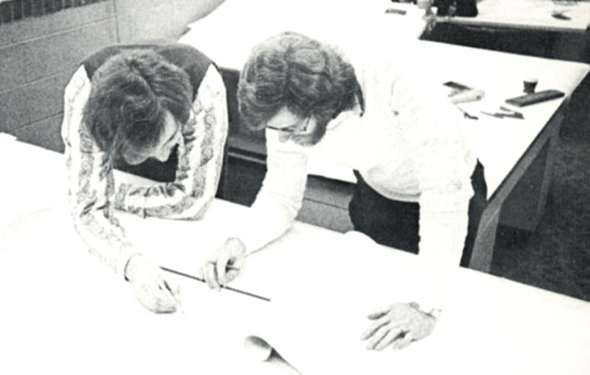
Gary Leideker and Fred Huysentruyt reviewing some plans in the early 1970’s.
Way back in the 1960s, Warren Anderson, known to acquaintances as “Andy,” had thoughts of beginning his own engineering firm, but it was a somewhat daunting task. He was already employed as Macomb County’s Highway Engineer by what was then known as the Macomb County Road Commission, now the Department of Roads, in Mount Clemens.
Striking out on his own was something he dreamed of, but thoughts of leaving the security of his position with the county caused him a lot of reflection. His will to move forward with his plans and dreams, but leaving a job with a steady income caused him to seek the advice and counsel of his friends at the Road Commission, George Eckstein and Bill Westrick.
Eckstein and Westrick were engaged in road and bridge design and construction, and the three men got together at Anderson’s home in 1967. After some lengthy discussions over a period of time, they formed an alliance that led to the beginnings of the new consulting firm.
They discussed and agreed on staffing numbers, the location of the firm, financing considerations, and how best to bring clients into the new venture. Later in the year, with Eckstein and Westrick maintaining their employment with the county, Anderson announced his resignation from his position as Highway Engineer, and the establishment of the new firm.
Anderson and Associates was established as a sole proprietorship in 1968, with offices located in downtown Mount Clemens. A civil engineering acquaintance, Harry Fuller, along with a couple of part-time employees and one full time secretary had offices in the Mount Clemens Bank building in the city, and he agreed to share their space and services with the startup firm.
Anderson was well known in the county, and his popularity and professional expertise were very helpful in recruiting accounts for the new firm; the South Macomb Disposal Authority and developer Charles Gilson were his first clients.
Eckstein and Westrick assisted with projects during evenings and weekends in 1968 and 1969, and during this time surveying was contracted to Richmond surveyor William Charles Melching, and his employees, William (Sod) Soderberg, and William (Butch) Miller. A young engineer named Paul Bellhorn worked for Melching and Anderson on a part-time basis, and he first introduced both men to the computers. Richard (Rick) Florka joined the firm in January 1969 on a part time basis, and was the firm’s first draftsman; he moved to full-time status in January 1970.
Anderson and Associates client base and workload continued to grow, and in late 1969 George Eckstein resigned his position at the Road Commission, and joined the firm in February 1970, becoming the firm’s fourth employee. The firm was incorporated as Anderson, Eckstein and Associates, Inc. in December 1969. New clients included the City of Roseville, Macomb County Road Commission, Macomb County Drain Commission, Utica Schools, South Macomb Sanitary District, and Berz Airport. The developing firm also added a number of developers, including Active Homes, Edward Schultz, Dominic Moceri and Republic Development.
With the growth in business and staffing, additional office space became necessary, and in 1971, the firm, along with Harry Fuller, moved to newly renovated quarters in the former Medea Hotel, which was located on South Gratiot Avenue in Mount Clemens. The hotel was later demolished and the site is now home to the Macomb County Administration building.
Gary Leideker joined the firm as a draftsman in September 1971, and Fred Huysentruyt, also a draftsman, joined in January 1972.
The plans that Anderson, Eckstein and Westrick originated in 1967 reached fruition in March 1972, when Bill Westrick left his position at the Road Commission and joined the firm, becoming the third principal engineer. At this time, the firm’s name was again changed, this time to Anderson, Eckstein and Westrick, Inc., with the three men becoming shareholders and directors of the new corporation.
The founders concurred at the time that they would focus their efforts mainly on Macomb County, but were open to branching out to additional communities as the need arose. They were pleased with the expanding customer base that consisted of a cross-section of public and private clients, and their financial condition was positive so that no outside funding was needed.
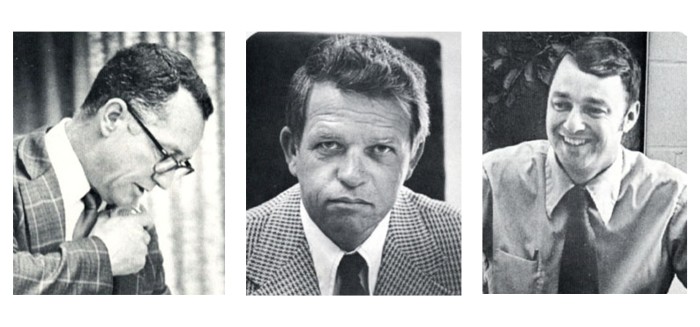 Photos of our founders in 1976. Pictured from left to right: George Eckstein, Warren Anderson, and William Westrick
Photos of our founders in 1976. Pictured from left to right: George Eckstein, Warren Anderson, and William Westrick
Expansion
Their staffing model needed some refinements as time progressed, with the realization that they had no surveyors or construction inspectors on staff, and the contractual agreement they had with Surveyor Chuck Melching wasn’t ideal as he was also serving other clients, causing scheduling difficulties.
Bill Soderberg and Butch Miller, then employees of Surveyor Chuck Melching, were recruited to join the AEW staff, and in January 1973 they did join up with AEW, forming the core of our Survey Department. Cliff Jackman also joined the department in October 1973.
With the growth in business and staffing, office space became a prime consideration; they were outgrowing the inadequate and inefficient space in the Medea, and the lack of parking space and security were also factors that led to the construction of a building in the early 1970s. The new AEW headquarters was located on Garfield Road, near 19 Mile, and the AEW team moved into the new building in 1973, with Harry Fuller electing to stay in the Medea space.
Larry Fontana joined the firm in January 1974 to assist the surveying department, and he also performed the construction inspection for the paving of Little Mack in Roseville. This launched our Inspection Department and there were then 11 full time employees.
Larry Miller started as a co-op in June 1976, and became a graduate engineer at the firm in May 1978. Lou Urban Sr. joined AEW as an engineer in March 1978, and Shelby Money came on board as a surveyor in May 1979.
Business was growing rapidly, and soon the “new” office space was once-again inadequate. The more than 50 employees were crowded into every available space, including what once was the conference room. A building addition was constructed in 1978, and a garage was also constructed at that time to house field equipment.
The client base continued to expand, and then included Macomb Community College, L’Anse Creuse Schools, the St. Clair County Road Commission, Village of Armada, Chateau Estates, Village of New Haven, General Motors, MJC Builders, Aldo Marrocco, Trinity Land, Elro Company, Chippewa Valley Schools, and the City of Warren.
Bill Soderberg and Paul Bellhorn became directors and shareholders in 1977, and during this time, a plan was fashioned to plan for the gradual transfer of ownership from the original three owners to younger key employees in order to perpetuate the firm; this plan remains in place today.
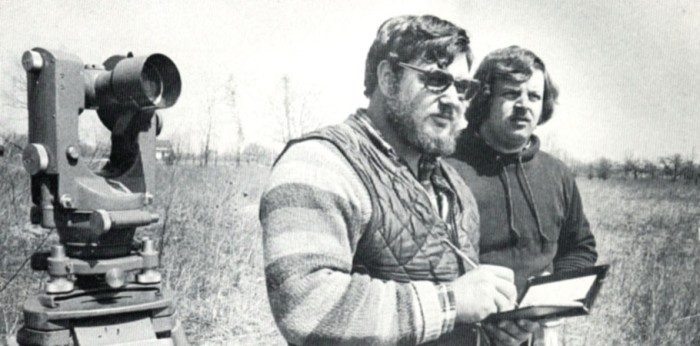 AEW Survey Crew in 1976
AEW Survey Crew in 1976
AEW Bridge Design, Inc.
AEW directors saw an opportunity to expand the business by including structural design capability, especially for highway bridges, in 1973, and learned that Arnold Pavlizke was a retired Wayne County bridge design engineer with an interest in joining the firm. A second corporation was formed in June 1973 by the shareholders of Anderson, Eckstein and Westrick.
The new firm was named Anderson, Eckstein and Westrick – Bridge Design, Inc., to advance the AEW brand identity. Pavlizke was hired by the new firm in February 1974, and became a shareholder and president in March 1974.
Several bridges in Macomb, St. Clair, and Lapeer counties were designed by the firm in the 70s and 80s, including bridges on Garfield Road over the Main Branch of the Clinton River in Clinton Township, and Schoenherr Road, 14 Mile and Utica Road, bridges, all crossing the Red Run Drain in Clinton Township and Sterling Heights, and the North Branch of the Clinton River in Clinton Township. The Bridge Design firm operated until Pavlizke’s retirement in October 1985.
To ensure bridge design and other structural engineering capabilities, Roy Rose was brought into the original firm in May 1985, and the Bridge Design firm was dissolved in 1992.
Economic Downturn
Michigan, Macomb County, and surrounding areas were impacted by a severe economic recession that began in 1979 and continued during 1980 and 1981, resulting in high inflation and interest rates. Unemployment was also at historically high levels, land development and housing construction fell off significantly, and all of these factors combined to cause substantial financial harm to AEW, our clients, and our employees. Staffing and pay reductions were put into place, that while painful, helped the firm survive the difficult economic times that were especially evident in the private client workload.
AEW continued to serve our clients, many of whom were also experiencing the same economic difficulties during this time.
Larry Miller and Lou Urban, Sr., became shareholders in October 1981.
Lou Urban, Sr., passed away in August 1983.
Florida Branch
Seeking to both survive, and also grow the firm, Warren Anderson, who had spent considerable time in Florida, advocated for expanding AEW into Florida where the economy, while stagnating, was still better than we were experiencing in Michigan in the early 80s. A number of contractors and workers seeking employment migrated there during this time, and the staff at AEW was reduced to 14 employees, a sign of the tough times we were all experiencing.
George Eckstein and Paul Bellhorn made a trip to Florida in 1981 to explore the best area for a branch office for the firm, and their research, which may have been influenced by the fact that Anderson had a home in the area, led to the opening of a Clearwater branch office. Bellhorn moved to Florida in July 1981, opened the office, and began the difficult task of finding work for the firm; competition was intense, but he did have some success in landing private sector work. Public sector work was even more difficult, somewhat due to the fact that we weren’t a local business.
Survey work was also difficult to obtain until Bellhorn was introduced to Harry Marlow, a surveyor who had an office in nearby Pinellas Park. The new association worked well, and Marlow was instrumental in gaining work for the new venture. Rick Florka joined Bellhorn in 1982, and the AEW branch moved to Marlow’s office in Pinellas Park at that time.
AEW and Marlow reached an agreement to merge in 1983, with the Marlow firm becoming a subsidiary of AEW, and Marlow became a shareholder in AEW. He built a new building adjacent to his existing office for the new AEW branch, and gaining private engineering work continued to be very difficult, with public work close to non-existent, with the exception of surveying.
They worked together through this challenging period, with work still being very difficult to come by, and finances continually strained. After some time, and a number of discussions, AEW and Marlow agreed in 1986 to once-again separate the two firms back to their original arrangements in 1986, and AEW closed their Florida operation.
At this time, both Bellhorn and Marlow sold their stock back to AEW, with Bellhorn remaining in Florida, where he started his own consulting firm, Marlow continued his surveying practice, and Florka moved to Ft. Meyers to pursue a new venture.
Growth
With Michigan’s economy beginning to rebound in 1983, AEW was once-again in a position to expand our workforce. New clients added during the 80s included the cities of Birmingham, Eastpointe, and Mount Clemens; the townships of Bruce, Chesterfield, Harrison, Ray and Shelby; GTR Builders, the Huron-Clinton Metropolitan Authority, and Beaumont Hospital. Our staffing increased commensurate with the increasing work flow during this time.
Leadership Changes
Warren Anderson suffered a major heart attack while on the job in March 1984, and was unable to return to work as a result of the illness. He and his wife, Lois, then retired to Florida, and while she still resides in Clearwater, Andy passed away in 1999.
George Eckstein became president of AEW in 1984, and directors/shareholders at that time were Eckstein, Westrick, Bellhorn, Soderberg, Marlow, and Miller. Shelby Money became a shareholder and director in 1985, and Roy Rose and Fred Huysentruyt became shareholders in 1986. Jim Rabine and Gary Leideker became shareholders in 1987.
AEW had a staff of 55 at the end of 1986.
Architectural Services
AEW continually seeks out ways to improve our services to our valued clients, and in 1987 we established the Architectural Department to better serve our private and public clientele. Ed Nieman joined this new department in our firm the same year, following a number of years working in Atlanta, Georgia, where he participated in a number of projects across the United States and internationally. Early projects included small commercial developments, park facilities, clubhouses, and small projects for municipal clients, with both projects and staff increasing during the late 80s and 90s. Projects included schools for Armada and Chippewa Valley Schools, municipal facilities, and office buildings.
Ed Neiman and Larry Fontana became shareholders in 1989.
With the shareholders numbering 10 in 1989, the Board of Directors was established at five members who were elected by shareholders. Officers and Directors at this time were George Eckstein, President, Bill Westrick, Executive Vice President, Larry Miller, Secretary/Treasurer, Roy Rose and Bill Soderberg were Vice Presidents.
The five-member Board of Directors model remains, while some of the Directors have changed over the years.
Staff numbered 77 in 1989.
New Building
With both business and staffing numbers growing, we had outgrown our Garfield Road facilities. We were renting space in an adjacent building, and we needed additional space for staff and equipment for our surveying department. A partnership, Wedgewood Investment Company, was formed by AEW shareholders as partners. The site of our current location on Schoenherr
Road in Shelby Township was acquired, plans were drawn by the AEW Architectural Department, financing was obtained by the partnership, and construction of the new building commenced in 1991. We moved into the new facilities in January 1992, and at that time the major portion of the east end of the building was leased to a group of doctors for their medical offices. The doctors were eventually moved to a newly-constructed building just to the south of our building.
Following some improvements to the west end of the second floor, and installation of an elevator, Larry Fontana, and the Inspection Department moved into the newly improved space. Soon after, the Surveying Department also moved, and also occupied the second floor space. The east end of the second floor was used as a storage area until 1995, when the storage area was moved to existing attic space. At this time the Inspection Department was moved to the east end of the second floor.
Another economic downturn occurred in 1991 and 1992, and our staff was once-again reduced, reaching a low of 47 in December 1992. Fortunately business improved, and we began experiencing a steady increase in employment beginning in 1993.
Craig Amey, Lyle Winn, Steve Pangori, and Gordon Wilson all became shareholders of the firm in October 1992, and the shareholders numbered 14.
Bill Westrick became President in 1993.
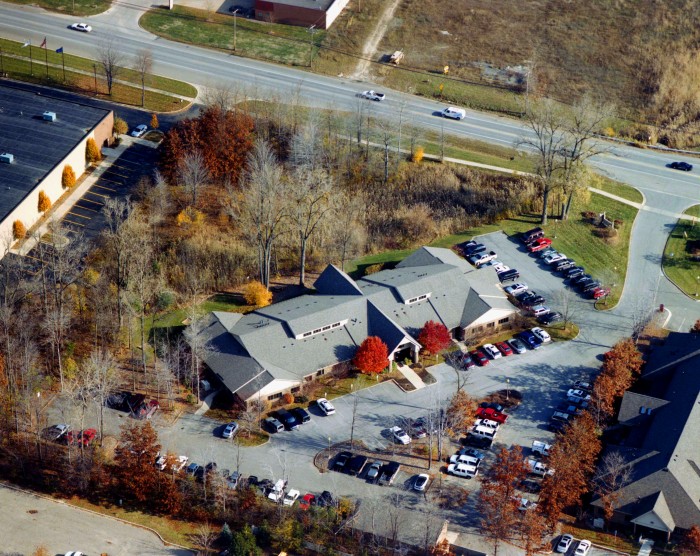 Aerial view of the current AEW office building in Shelby Township.
Aerial view of the current AEW office building in Shelby Township.
Additional Expansion
The owners of the consulting engineering firm of Pate, Hirn and Bogue (PHB) expressed an interest in retiring, and potentially closing their firm in 1994. AEW principals arranged for Larry Pate and John DeBusscher to serve as consultants for our firm to assist in transferring their municipal clients to AEW. This was a very successful collaboration, and AEW became the consulting engineers for the cities of Center Line, Fraser, Grosse Pointe Woods, Harper Woods, Pleasant Ridge and St. Clair Shores in 1994. AEW also hired Frank Varicalli and Paul Rakin from the PHB staff.
Additional Leadership Changes
George Eckstein and Bill Soderberg retired in 1994, and Shelby Money took over leadership of the Survey Department.
At this time the Board of Directors included Bill Westrick, Larry Miller, Roy Rose, Shelby Money, and Ed Neiman.
Employee count at the end of 1994 was 76.
Bill Soderberg passed away in April 2003.
Bill Westrick implemented AEW’s “Total Quality Management” (TQM) program in 1994.
Geographic Information Services (GIS) Added
AEW has always strived to serve our clients with the most state-of-the-art equipment available, and the GIS department was created in 1994.
GIS services include: Needs Assessment, Implementation Planning, GPS Control, Parcel Base Mapping, Site Modeling, Infrastructure Mapping, Database Design, Data Conversion, Customization, Maintenance and Training.
New Office Locations and 30, 40 and 45 Year Anniversaries
With the firm growing in areas that were somewhat distant to the corporate office in Shelby Twp., a Roseville office was opened in 1996, and a Kensington/New Hudson office opened in 1998. The Kensington/New Hudson office closed in 2007.
AEW celebrated 30 years in business in 1998.
AEW celebrated 40 years in business in 2008.
AEW celebrated 45 years in business in 2013.
AEW Awards Continue to Grow
The firm was awarded the “National Award of Excellence” from the American Concrete Paving Association (ACPA) in 1998 for their “Nautical Mile” Reconstruction work.
AEW was first recognized as a “Top 50 Trenchless Design Firm” in 2000.
AEW was acknowledged as a “Top 100 Architecture, Engineering & Construction” (AEC) firm in 2005.
AEW won the American Society of Engineering Companies (ASEC) Award of Merit in 2008 for their work on the North Gratiot Interceptor – Phase 1 project. Phase two of the project began in 2010.
Roy Rose was presented with the ASCE Michigan Branch “Franklin D. Myers Outstanding Engineer of the Year Award” in 2016.
In October 2016 AEW was recognized by “Trenchless Technology” magazine as their “Rehabilitation Project of the Year” for the work our firm, in conjunction with a team of other professionals, performed on the Oakland Macomb Interceptor Drain (OMID).
New Website
The firm launched a new website, replacing an earlier version, mid-year in 2016.
The updated site is responsive to different types of devices, and now allows users to easily browse content on any mobile device as well. It has an upgraded user experience, a fresh and modern design, includes a comprehensive portfolio of projects with high quality photography, a revamped news section that is fully searchable by Google and other search engines, and is structured for optimized site hierarchy, which allows for more easily browsed content and a higher volume of interested web traffic to the site. AEW also began using social media platforms and digital newsletters as a way to connect with employees, clients and other contacts.
Employee Headcount Continues to Increase
With the improving economy and the increasing work load that it generated, the firm had 115 employees in 2016.
With the economic downturn in 1991 and 1992, our staff was significantly reduced, reaching a low of 47 in December 1992. Fortunately business improved, and we began experiencing a steady increase in employment beginning in 1993.
The firm’s highest level of employment was in July 2005, at which point we had 146 employees.
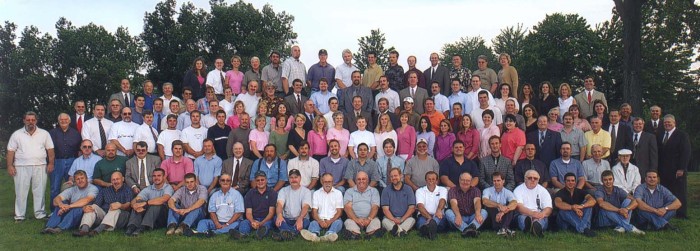 Group employee photo taken in 2003 to celebrate AEW’s 35th year of business.
Group employee photo taken in 2003 to celebrate AEW’s 35th year of business.
Important Dates in the History of AEW
1968: Warren (Andy) Anderson establishes Anderson and Associates as a sole proprietorship.
Harry Fuller, a civil engineering acquaintance with a couple of part-time employees and one full time secretary, had offices in the Mount Clemens Bank building in the city, and he agreed to share his space and the services of his staff at that time.
Surveying was contracted to Richmond Surveyor William Charles Melching, and his employees, William (Sod) Soderberg, and William (Butch) Miller. A young engineer, Paul Bellhorn, also worked for Melching, and Anderson hired him on a part-time basis, and Bellhorn introduced both men to the early days of the “Computer Age.”
1969: Richard Florka was hired as the firm’s first draftsman. The firm is incorporated as Anderson, Eckstein and Associates.
1970: George Eckstein joins the firm as their fourth employee. The firm, along with Harry Fuller, moved to newly renovated quarters in the former Medea Hotel on South Gratiot in downtown Mount Clemens.
1971: Gary Leideker joined the firm as a draftsman.
1972: Bill Westrick joins the firm in 1972, becoming the firm’s third principal engineer. The firm’s name was changed again, this time to Anderson, Eckstein, and Westrick, Inc. All three men became shareholders and directors of the new corporation.
Fred Huysentruyt joined the firm as a draftsman.
1973: Bill Soderberg and Butch Miller joined the firm, and formed the core of our Survey Department. Cliff Jackman also joined the department.
Having outgrown the space in the Medea Hotel location, a new building was constructed on Garfield Road, near 19 Mile, and the firm moved to the new quarters, with Harry Fuller electing to remain in the Medea Hotel location.
AEW Bridge Design, Inc. is formed to expand AEW’s structural design capability, especially for highway bridges.
1974: Arnold Pavlizke, a retired Wayne County bridge design engineer, joined the firm, and became a shareholder and president of AEW Bridge Design the same year.
Larry Fontana joined in 1974 to assist the surveying department, and he also performed the construction inspection for the paving of Little Mack in Roseville. This launched our Inspection Department, and there were then 11 employees on staff.
1976: Larry Miller started with the firm as a co-op, and became a graduate engineer in 1978.
1977: Bill Soderberg and Paul Bellhorn became directors and shareholders, and a plan was fashioned to plan for the gradual transfer of ownership from the original three owners to younger key employees in order to perpetuate the firm; this plan remains in place today.
1978: The “new” building, constructed in 1973, became too small, with more than 50 employees housed there, and an addition was constructed, along with a garage to house field equipment.
Lou Urban Sr. joined the firm as an engineer.
1979: Shelby Money joined the firm as a surveyor.
1981: Larry Miller and Lou Urban Sr. became shareholders.
AEW opens Clearwater, Florida branch office with Paul Bellhorn in charge; he formed an association with surveyor Harry Marlow of nearby Pinellas Park.
1982: Rick Florka joined Bellhorn at this time, and the AEW branch moved to Marlow’s Pinellas Park offices at that time.
1983: AEW and Marlow merged, with the Marlow firm becoming a subsidiary of AEW, and Marlow became a shareholder at that time.
Lou Urban Sr. passed away.
1984: Warren Anderson suffered a major heart attack while on the job, and was unable to return to work. George Eckstein became President of AEW, and directors at that time were Eckstein, Westrick, Bellhorn, Soderberg, Marlow, and Miller.
1985: Arnold Pavlizke retired as president of AEW Bridge Design, Inc.
Shelby Money became a shareholder and director.
Roy Rose joined the original AEW firm to assist with bridge design and other structural engineering.
1986: AEW and Marlow agreed to separate the two firms back to their original arrangements, and AEW closed their Florida operation. Bellhorn and Marlow sold their stock back to AEW, with Bellhorn remaining in Florida, where he started his own consulting firm. Marlow continued his surveying practice, and Florka pursued a new venture.
Roy Rose and Fred Huysentruyt became shareholders.
AEW had a staff of 55 at the end of 1986.
1987: The Architectural Services Department was formed, and Ed Nieman joined our firm, and the new department this year.
Jim Rabine and Gary Leideker became shareholders.
1988: AEW celebrated their 20 years in business anniversary.
1989: There were 10 shareholders this year, and the Board of Directors was established at five members who were elected by shareholders. Officers and Directors at this time were George Eckstein, President, Bill Westrick, Executive Vice President, Larry Miller, Secretary/Treasurer, and Roy Rose and Bill Soderberg were Vice Presidents.
The five-member Board of Directors model remains in place today, and some of the Directors have changed over the years.
Ed Nieman and Larry Fontana became shareholders.
Staff numbered 77 at the end of 1989.
1992: Having outgrown our Garfield Road facilities, a new partnership, Wedgewood Investment Company, was formed by AEW shareholders, and the site of our current location on Schoenherr was acquired, with construction beginning in 1991, and we occupied the new building in January 1992.
Owing to an economic downturn, our staff numbered 47 at this time.
Craig Amey, Lyle Winn, Steve Pangori, and Gordon Wilson became shareholders, and our shareholders numbered 14.
AEW Bridge Design, Inc., was dissolved.
1993: Bill Westrick became President, and George Eckstein, Executive Vice President this year.
1994: The owners of the consulting engineering firm of Pate, Hirn and Bogue expressed an interest in retiring, and potentially closing their firm in 1994. The men served AEW as consultants in a very successful collaboration, assisting in transferring their existing municipal clients to AEW.
George Eckstein and Bill Soderberg retired this year.
The Board of Directors included Bill Westrick, President, Roy Rose, Executive Vice President, Larry Miller, Secretary/Treasurer, and Shelby Money and Ed Neiman were both Vice Presidents.
The Geographic Information Systems (GIS) department was added this year.
Employee count at the end of 1994 was 76.
1996: Keeping pace with the expanding business, a Roseville office was opened this year.
1998: With the expanding business, and the geography AEW was covering, another new office was added in Kensington/New Hudson.
1999: Warren Anderson passed away.
2001: Bill Westrick partially retires, and Roy Rose was elected President of the firm.
The Board of Directors included Roy Rose, President, Larry Miller, Executive Vice President & Secretary/Treasurer, and Shelby Money, Steve Pangori, and Gordon Wilson were all Vice Presidents.
2003: Bill Soderberg passed away.
2005: AEW records highest employment in our history; we had 146 employees in July.
2007: Kensington/New Hudson Office Closes.
2008: AEW celebrates 40 years in business anniversary.
2009: Scott Lockwood named to Board of Directors in October.
2012: Shelby Money retired in June.
Vanessa Hayes named to Board of Directors in October.
Kyle Seidel became a shareholder.
2013: AEW celebrates 45 years in business anniversary.
Ed Nieman and Larry Miller retired in December.
2014: James Rabine retired this year.
2015: Jason Arlow, Aseel Putros, Mike Smith, Lou Urban and Mike Vigneron became shareholders.
Jennifer Chehab left for a new opportunity.
2016: With the growing economy and the increasing workload, employment reached 115 in 2016, and remained very similar through 2017.
Mike Truax, Frank Varicalli and Kevin Zauel became shareholders.
2017: Roy Rose became Chairman of the Board, and Stephen Pangori became President & CEO
Juli Sala became a shareholder.
Jeff Bednar left for a new opportunity.
Craig Duckwitz retired this year.
2018: AEW Celebrates our 50th Anniversary, 1968 – 2018
The Board of Directors:
Roy Rose, PE, Chairman of the Board
Stephen Pangori, PE, President & CEO
Gordon Wilson, PE, Executive Vice President
Scott Lockwood, PE, Executive Vice President
Vanessa Hayes, CPA, CFO, Secretary/Treasurer
